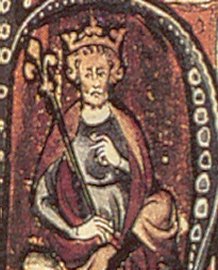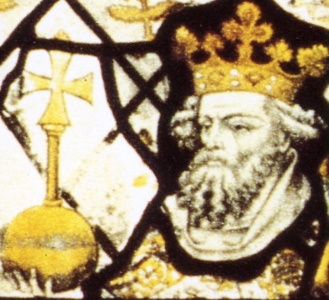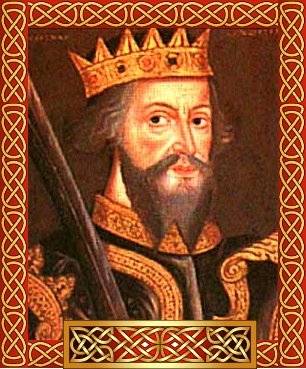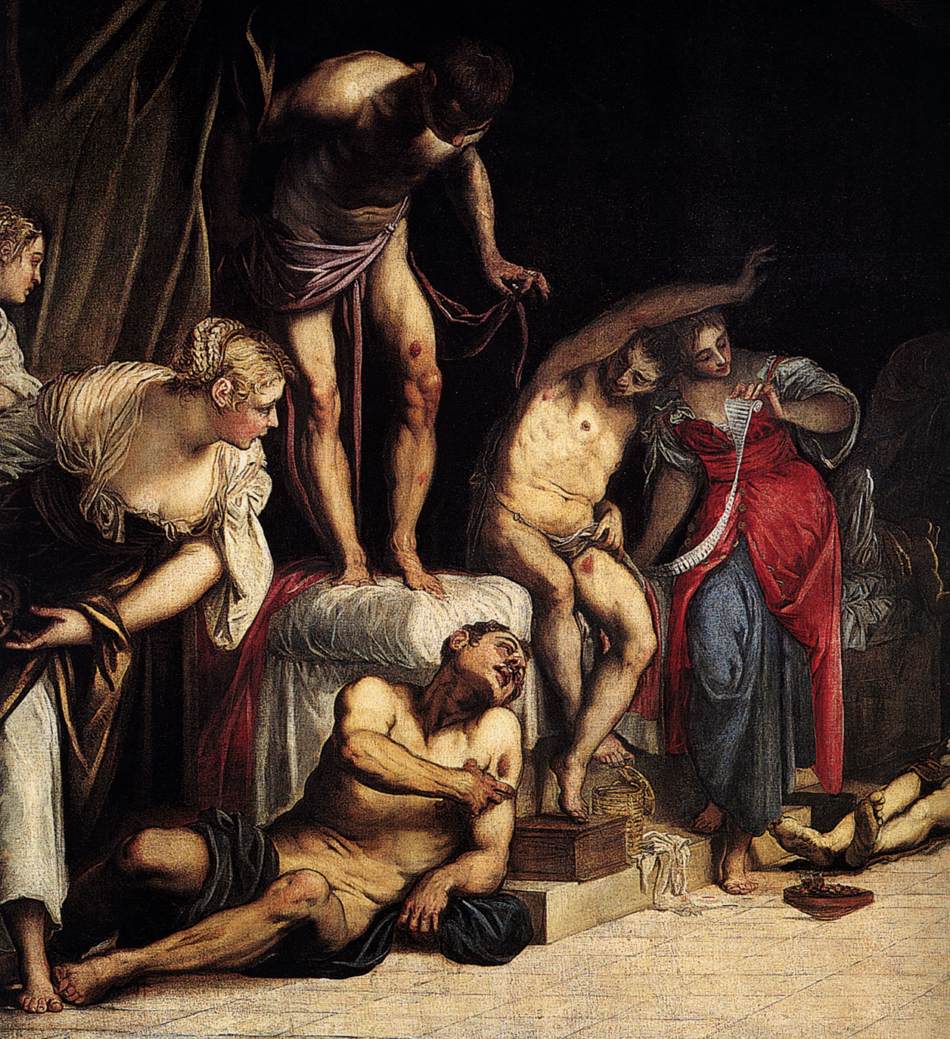Pictured: A 13th century portrait of Cnut the Great. It shows him as a king of Christendom.
Name: King Cnut (Canute)
Born: c.995 at Denmark
Parents: Sweyn I (Forkbeard) and Gunhilda
Relation to Elizabeth II: husband of the 27th great-grandaunt
House of: Denmark
Ascended to the throne: November 30, 1016
Crowned: January, 1017 at Old St Paul’s Cathedral, aged c.22
Married: (1) Emma of Normandy (2) Elfigfu
Children: 3 sons including Harold I and Harthacnut, 1 daughter, several illegitimate children
Died: November 12, 1035 at Shaftesbury
Buried at: Winchester
Reigned for: 18 years, 11 months, and 11 days
Succeeded by: his son Harold
King of England from 1016, Denmark from 1018, and Norway from 1028. Having invaded England in 1013 with his father, Sweyn, king of Denmark, he was acclaimed king on Sweyn’s death in 1014 by his Viking army. Canute defeated Edmund (II) Ironside at Assandun, Essex, in 1016, and became king of all England on Edmund’s death. He succeeded his brother Harold as king of Denmark in 1018, compelled King Malcolm to pay homage by invading Scotland in about 1027, and conquered Norway in 1028. He was succeeded by his illegitimate son Harold I.
Under Canute’s rule English trade improved, and he gained favour with his English subjects by sending soldiers back to Denmark. The legend of Canute disenchanting his flattering courtiers by showing that the sea would not retreat at his command was first told by Henry of Huntingdon in 1130
Canute and Edmund Ironside split up England, and Canute ruled Mercia and Northumbria until he inherited the whole kingdom. The empire collapsed on his death. He was buried at Winchester.
Cnut the Great (Old Norse: Knútr inn ríki; c. 985 or 995 – 12 November 1035), more commonly known as Canute, was a king of Denmark, England, Norway and parts of Sweden. After the death of his heirs within a decade of his own and the Norman conquest of England in 1066, his legacy was largely lost to history. Historian Norman F. Cantor has made the paradoxical statement that he was “the most effective king in Anglo-Saxon history”, despite his not being Anglo-Saxon.
Cnut was of Danish and Slavic descent. His father was Sweyn Forkbeard, King of Denmark (which gave Cnut the patronym Sweynsson, Old Norse Sveinsson). Cnut’s mother was the daughter of the first duke of the Polans, Mieszko I; her name may have been Świętosława (see: Sigrid Storråda), but the Oxford DNB article on Cnut states that her name is unknown.
As a prince of Denmark, Cnut won the throne of England in 1016 in the wake of centuries of Viking activity in northwestern Europe. His accession to the Danish throne in 1018 brought the crowns of England and Denmark together. Cnut maintained his power by uniting Danes and Englishmen under cultural bonds of wealth and custom, rather than sheer brutality. After a decade of conflict with opponents in Scandinavia, Cnut claimed the crown of Norway in Trondheim in 1028. The Swedish city Sigtuna was held by Cnut. He had coins struck which called him king there, but there is no narrative record of his occupation.
The kingship of England lent the Danes an important link to the maritime zone between the islands of Great Britain and Ireland, where Cnut, like his father before him, had a strong interest and wielded much influence among the Gall-Ghaedhil.
Cnut’s possession of England’s dioceses and the continental Diocese of Denmark – with a claim laid upon it by the Holy Roman Empire’s Archdiocese of Hamburg-Bremen – was a source of great leverage within the Church, gaining notable concessions from Pope Benedict VIII, and his successor John XIX, such as one on the price of the pallium of his bishops. Cnut also gained concessions on the tolls his people had to pay on the way to Rome from other magnates of medieval Christendom, at the coronation of the Holy Roman Emperor. After his 1026 victory against Norway and Sweden, and on his way to Rome for this coronation, Cnut, in a letter written for the benefit of his subjects, stated himself “king of all England and Denmark and the Norwegians and of some of the Swedes”.
Death and succession
A 13th century portrait of Cnut the Great. It shows him as a king of Christendom.
Cnut died in 1035, at the Abbey in Shaftesbury, Dorset. His burial was in Winchester, the English capital of the time, and stronghold of the royal house of Wessex, whom the Danes had overthrown more or less two decades before.
In Denmark he was succeeded by Harthacnut, reigning as Cnut III, although with a war in Scandinavia against Magnus I of Norway, Harthacnut was “forsaken [by the English] because he was too long in Denmark”,[90] and his mother Queen Emma, previously resident at Winchester with some of her son’s housecarls, was made to flee to Bruges, in Flanders; under pressure from supporters of Cnut’s other son – after Svein – by Ælfgifu of Northampton. Harold Harefoot – regent in England 1035–37 – succeeded to claim the throne, in 1037, reigning until his death in 1040. Eventual peace in Scandinavia left Harthacnut free to claim the throne himself, in 1040, and regain his mother her place.[citation needed] He brought the crowns of Denmark and England together again, until his death, in 1042. Denmark fell into a period of disorder with the power struggle between the pretender to the throne Sweyn Estridsson, son of Ulf, and the Norwegian king, until Magnus’ death in 1047 and restoration of the Danish sovereignty.[citation needed] And the inheritance of England was briefly to return to its Anglo-Saxon lineage.
The house of Wessex was to reign again in Edward the Confessor, whom Harthacnut his half-brother – had brought out of exile in Normandy and made a treaty with.[citation needed] Like in his treaty with Magnus, it was decreed the throne was to go to Edward if Harthacnut died with no legitimate male heir. In 1042, Harthacnut died, and Edward was king. His reign meant Norman influence at Court was on the rise thereafter,[citation needed] and the ambitions of its dukes finally found fruition in 1066, with William the Conqueror’s invasion of England, and crowning, fifty years after Cnut was crowned in 1016.
Had the sons of Cnut not died within a decade of him, and his (only known) daughter Cunigund – set to marry Conrad II’s son Henry III eight months after his death – not died in Italy before she became empress,[91] Cnut’s reign might well have been the foundation for a complete political union between England and Scandinavia.
Bones at Winchester
The new regime of Normandy was keen to signal its arrival with an ambitious programme of grandiose cathedrals and castles throughout the High Middle Ages. Winchester Cathedral was built on the old Anglo-Saxon site (Old Minster) and the previous burials were set in mortuary chests there. Then, during the English Civil War, in the 17th century, plundering Roundhead soldiers scattered the bones on the floor, and the bones of Cnut were spread amongst the various other chests of rulers: notably William Rufus. After the restoration of the monarchy, the bones were collected and replaced randomly in their chests.
| Timeline for King Cnut (Canute) |
| 1017 | Canute marries Emma of Normandy, the widow of Aethelred II. Canute divides England into four earldoms – Northumbria Wessex, Mercia and East Anglia. |
| 1027 | Canute makes a pilgrimage to Rome to demonstrate his alliance with the Church, and attends the coronation of the Pope |
| 1028 | In addition to his existing kingdoms Canute becomes King of Norway |
| 1035 | Canute dies at the age of 40, and his huge Northern European empire disintegrates. |
Credits:
Wikipedia
http://www.britroyals.com/




















